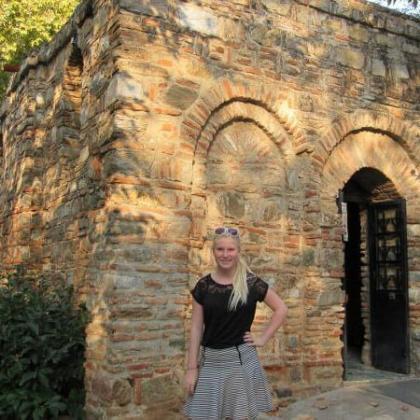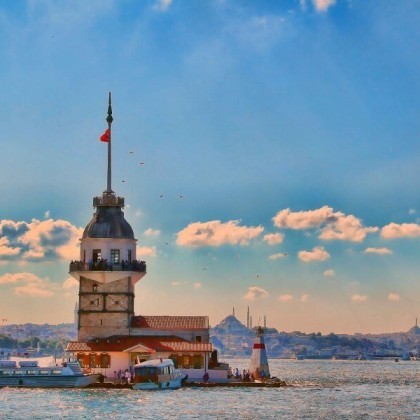Lake Van
The waters of Lake Van are a magical reflecting pool, turquoise by day, red at sunset, and quicksilver after dusk. The silken iridescence of this inland sea comes from its alkaline soda waters, but the mountains and castles along its shores reflect the millennia of volcanic and human activity” that have shaped the region. For 3000 years, the area around Lake Van has been Eastern Turkey’s most vibrant and fascinating cultural center. In approximately 800 BC, the Urartian Kings established their capital here, building impressive citadels and canals throughout the region. Van’s strategic location on the Silk Road (İpek Yol) ensured prosperity and power for its rulers. After the Urartians came the Assyrians, Persians, and Armenians, before the Selçuk and then the Ottoman Turks. In the 20th century, Van witnessed the most tragic chapter in the Turkish Armenian conflict.
Istanbul New Year’s Eve Party Cruise on the Bosphorus
IstanbulWith this new year's eve party program in Istanbul, you will have an amazing new year party on the Bosphorus. Book it now and don't miss the special price!
View Tour3 Days Ephesus, Pergamon and Pamukkale Tour Package
Ephesus, Pamukkale, PergamonIf you want to make an amazing trip to the Ephesus, Pergamon, and Pamukkale, you should read our tour itinerary.
View TourIstanbul and Cappadocia Tour – 7 Days
Istanbul, Cappadocia, TurkeyIf you want to make a trip to Istanbul and Cappadocia both, we strongly suggest you join this amazing package tour. This tour covers all the accommodations, transportations, lunches...
View TourBest of Turkey Package Tour – 8 Days
Istanbul, Cappadocia, Ephesus, PamukkaleAre you looking for a good traveling package in Turkey? With our 8-days Turkey tour, you will make a trip to every important sight in Turkey. Enquire now for...
View Tour
To the southeast, the Zob River valley flows toward Hakkâri and Iraq. Present- day Van is the heart of Turkish Kurdistan, and in the early 1990s the area became infamous for PKK tourist abductions. In recent years, however, successful jandarma campaigns have all but eliminated the PKK threat, and tourists are once again flocking to Lake Van’s shores and the fortresses that surround them.
The ruins of Tuşba (Old Van) lie on the eastern shore of the great lake in the shadow of a crumbling fortress. Although Van has been the capital of the region for some three millennia, the new city (4km east of the ruins) is barely 80 years old, having been completely rebuilt after the Russian siege of 1915-1918. Van has a long and tragic history of political strife and ethnic upheaval. It was here, in the 1880s, that both the first organized Kurdish rebellion and the first Armenian moves for independence manifested themselves. Armenia’s alliance with Russia triggered the forced exile and slaughter of 1.5 million Armenians (see Armenians, p. 25). Today, over one million people live in the Van area, and the population (apart from the army and government officials) is almost entirely made up of ethnic Kurds, who are still only provisionally allowed to speak their native language. The modem city is surprisingly secular, with halter tops and jeans for sale in the trendier boutiques along Cumhuriyet Cad. Vibrant, warm, and well-equipped for tourists, Van is a base for exploring the natural and historical marvels of the lake region.
TRANSPORTATION
Minibuses from points north drop off in the center of town at Beş Yol; otherwise, most travelers arrive at the airport (5km south) or the otogar (10km northwest of the city). Frequent dolmuş marked “iskele-Otogar” go to town ($.30). An airline bus usually meets flights at the airport. Otherwise, walk 300m to the main road for a $.40 dolmuş to avoid the $10 taxi.
- Flights: THY (216 53 54), on the corner of Cumhuriyet Cad. and Ordu Cad., has direct flights to Adana, Ankara, Antalya, Istanbul, and Trabzon, as well as international flights.
- Trains: Trains run from the station (223 13 80) west to Tatvan, Ankara, and İstanbul by loading onto a ferry to cross the lake; schedules are erratic but the trip is worth the wait. International trains run to Tehran, Iran (W, Su 6:30pm, $21).
- Buses: Van’s otogar services most destinations in Turkey. Best Van (214 28 81), Star Van (215 06 96), and Van Gölü (216 33 33) have ticket offices at the corners of K. Karabekir Cad. and Cumhuriyet Cad. Most companies have free transport to the bus station 30min. before departure. To: Ankara (18hr., 8 per day, $25); Antakya (18hr., 1 per day, $20); Diyarbakır (6hr., 6 per day, $11); Erzurum (6hr., 4 per day, $11); İstanbul (25hr.; 8am, 1pm; $36); İzmir (25hr., 3 per day, $37); Malatya (11hr., 6 per day, $13); Şanlıurfa (10hr., 2 per day, $13); and Trabzon (12hr., 1 per day, $20).
- Dolmuş: Dolmuş leave 4 times daily in the morning from 200m west of Beş Yol. to: Çaldıran ($2); Doğubeyazıt ($4); and Erçis ($3). Dolmuş to the Van Kale leave from 1 block north of Beş Yol; those for points south leave from Cumhuriyet Cad., 1 block south of K. Karabakir Cad.
- Car Rental: Several car rental agencies operate out of the airport. Hertz is the only one with an office in town, on Cumhuriyet Cad. (215 89 90; fax 215 98 91). $45 per day.
ORIENTATION AND PRACTICAL INFORMATION
Cumhuriyet Cad. rains the length of downtown, containing all the traveler’s needs between the Atatürk statue at İskele Cad. (Beş Yol) and the tourist information center, just south at K. Karabakir Cad. From Cumhuriyet Cad., both of these major streets run west, crossing the İpek Yol (Silk Road) before meeting the lake at the İskele Harbor and Van Kale, respectively.
- Tourist Office: (216 20 18 or 216 36 75), across from the Asur Otel in a yellow building marked “Turizm Müdürlüğü.” They offer brochures and a map, but speak little English. Open M-F 8am-noon and 1:30-5:30pm. For more complicated questions, go to the Buyuk Asur Hotel (216 37 53), across the road, where Remzi Bozbay (mobile (542) 784 64 30) speaks English, offers tourist information, and arranges tours to all sites in the region. His brother runs a kilim shop beneath the hotel and also gives tourist advice.
- Banks: Vakıf Bank (216 11 93) on Cumhuriyet Cad. across the street from the PTT, exchanges traveler’s checks with no commission. Open daily 8:30am-noon and 1:30- 5:30pm. ATMs line the main avenue.
- Medical and Emergency Services: The state hospital, Devlet Hastanesi (216 47 06) Is 300m south of Beş Yol on İskele Cad. The university-affiliated Araştirma Hastanesi (216 47 06) is midway between Cumhuriyet Cad. and İpek Yolu on K. Karabekir Cad. Both are large, modern facilities, with ambulance service.
- Internet Access: Van is littered with Internet cafes. The fastest is Cafe Net, upstairs at No. 71/1 on Cumhuriyet Cad.
- PTT: (214 34 90). On Cumhuriyet Cad. near Sok. 6. Large PTT with poste restante service and a row of Türk Telekom phones. Mail service open 6am-llpm; phones 24hr.
ACCOMMODATIONS
Most of Van’s accommodations are reasonably priced and well-furnished. The very cheapest hotels will entice only the most hard-core of budget travelers; for a little more, it’s easy to find clean and comfortable rooms. Camping along Van’s lake- shore is a beautiful and safe option as long as you stick to designated campgrounds. Edremit, 12km southwest of Van, charges $1-2 to set up a tent. Camping on Akdamar Island is prohibited, but. Ayanis Kale and the northeastern shoreline of Lake Van are perfect for camping and swimming along isolated rock beaches. Check with the local jandarma or Ramzi Bozbay in Van.
- Hotel Büyük Asur, Cumhuriyet Cad. and Turizm Sok. (216 87 92). This affordable hotel is a quality traveler’s hub with helpful, English-speaking hosts. All rooms have large beds and are well furnished, with 24hr. hot water showers. The lobby has a breezy breakfast deck and a traditional pillow lounge. Singles $12; doubles $16. Hotel Beşkardeş, 16 Cumhuriyet Cad. (215 50 30; fax 216 64 66), by the corner of K Karabakir Cad., offers bright, clean rooms with TV. Singles $8; doubles $15.
- Hotel Bayram, Cumhuriyet Cad. (216 11 36; fax 214 71 20). Comparable and just 30m from Büyük Asur, Bayram has quiet, newly furnished rooms with tiled bath and shower. Singles $10; doubles $20.
- Hotel İpek, Cumhuriyet Cad., Sok. 1, No. 3 (216 30 33). West of Cumhuriyet Cad. Sok. 1, in the heart of the Bit Bazaar. The best of the cheap places. Though basic, some rooms have showers, but share a bath. Singles $4; doubles $8; triples $12.
FOOD
Sadly, Kurdish cuisine has, for the most part, disappeared from restaurant menus, leaving behind standard Turkish fare. Breakfast in Van consists of delightful, fresh honey and oltu peynir (Kurdish white cheese with herbs) and is served in many kahvaltı salonu (breakfast houses) downtown. Van is a fairly dry city, but alcohol can be found in some small stores; look for the Efes Pilsen beer signs. Hotel bars, such as those at the upscale Hotel Urartu, across from the Devlet Hastanesi, offer music and drinks until midnight. At dusk, the outdoor along the Bit Bazaar fill up with locals.
- Merkez Et Lokantasi (216 97 01), on the busy corner of İskele Cad. and İpec Yolu. This is Van’s best, and worth the 1km trip from town. An artificial waterfall and stunning location complement dishes like sarma beyti (spicy garlic mince rolls). The brave of heart can try the delicious çiğ köfte: raw meat patties mixed with spices. Meal and soft drink $3-4. Open daily 9am-11pm.
- Cinar Restaurant (214 66 06), behind the Bayram Hotel. Broad menu, pleasant upstairs location, and great food. Full meal $3-4. Kitchen closes 9pm.
- Çem Et Lokantasi (215 21 11), on İskele Cad., 100m east of İpek Yolu. This friendly, well-lit restaurant features a wide variety of unidentified bird kebaps grilled in front of you while you dine. Full meal $2-4. Open until 10pm.
SIGHTS
Van’s astonishing natural beauty provides a backdrop for a unique blend of Urartian, Armenian, and Kurdish influences. To see them all at the relaxed pace the tranquility of the lake demands, you’ll need to plan for a several-day visit. If time is short, give priority to Akdamar Church, Hoşap Castle, Van Kale, and Çavuştepe Fortress (see Daytrips from Van, below).
After the Russians destroyed the old city of Tuşba, the local Kurds and their Turkish rulers built the new city of Van 4km to the east. Consequently, the museum is the only sight of historical importance in the town center, though the fortress and old city are an easy 30min. walk. The elusive Van cat—one eye green and one eye blue—is an increasingly rare sight in Van, as is the cantaloupe melon fabled to have been invented here. Carpet and kilim sellers here are tire primary distributors for western Turkish dealers. They are in a position to offer the same quality found in tourist areas for up to 70% less. Sene Kilim, crafted by Kurdish villagers in Northern Iran and Southeastern Turkey, are easy to find. Do not purchase carpets at high prices unless claims of age and rarity can be authenticated.
VAN MUSEUM
Van’s sole historical attraction is one of the better archaeological and ethnographic museums in Eastern Anatolia. The ground floor contains prehistoric finds from Tikiltepe as well as Urartian helmets, textile tools, bronze belts, glassware, and cremation bowls. The inner courtyard has large stone carvings of lions and Urartian cuneiform inscriptions. Upstairs is a kilim collection and a gallery called the “Genocide section,” which displays the remains of eight skeletons and presents a misleading portrayal of the slaughter of Turks by Armenians, conveniently omitting any mention of the Armenian genocide. (On Seyvit Mehmet Cad., behind the Beyram Hotel. Open daily 8am-noon and l:30-5:30pm. $1, students $.50.)
VAN KALE
Van Kale, a nearly 3000-year-old Urartian fortress towering high on rock bluffs, is simply massive: from east to west it stretches nearly 2km, 80m above the surface of the lake. Constructed by King Sarduri (840-830 BC) and known as Tuşba to the Urartians, it formed the center of their vast kingdom. Though many of the structures were destroyed by the Russian siege, Van Kale’s extensive battlements are worth a visit. Start at the lakeside end near the car park and çay garden. The large stone slabs near- the fishery are ancient Urartian piers. Up the hill on the west side lies the locked burial chamber of King Argisht with inscriptions on the wall. The gate can be unlocked by the caretaker. The king is buried deep in a carved cave with connecting rooms that held the garrison and supplies. Walking up the hill 150m brings you to a flat area that was once the site of the temple of sacrifice. The drainage ditch you see was for collecting the animal blood. Pass the Ottoman palace to the south end of the fortress, then stumble down a steep rocky hill at the west wall to reach the burial chambers of Urartian kings Menua and Sarduri . The top of the rock bluff, now bearing the remains of an Ottoman mosque and castle, offers a view of the old city. (Dolmuş (every 20mln.t $.30) depart from Beş Yol. Kale $2, students $1. Open 24hr., but escorts at night are recommended. Walking tour requires at least 2hr.; add an extra hour if visiting the old city off the western slopes.)
OLD VAN (TUŞBA)
Today, in Tuşba village, burial mounds stand as monuments to the cultural decimation that the area has suffered. The old city is part of a municipal park where locals often gather for late afternoon picnics and sunset strolls through the ruins. At the base of the fortress, the remains of an Armenian church are visible next to the foundation of a hamam. The two Selçuk mosques have been rebuilt; the southern one is still in use. Tire one with the peculiar minaret (still climbable with a flashlight and gumption) is what remains of the Ulu Camii built by the Persian-influenced Black Sheep Turcomans. (Open 24hr. Free.)
DAYTRIPS FROM VAN
A well-planned daytrip can incorporate Hoşap Castle, Lake Van, and a visit to Akdamar Church, arguably the pearls of the Van region.AKDAMAR The Church of the Holy Cross, on Akdamar Island, is a highlight of any visit to Van. The derivation of the name Akdamar is traceable through Armenian folklore. The Princess Tamara had fallen in love with a peasant boy on the mainland. Every night she would light a candle on the island, whereupon he would swim out to profess his love. Her father, the king, caught wind of this forbidden love, became very angry, and locked his daughter in the castle. One night the king put the candle on a boat and ordered it moved around the lake. The boy swam in endless circles, and with his last drowning gasp, shouted “Aght Tamara, AghtTamara!” (“Oh Tamara!”).
AKDAMAR CHURCH AND OTHER ARMENIAN CHURCHES
Akdamar Church is 50km west of Van on an island 5km off the coast. Dolmuş headed for Gevaş will take you the additional 9km to the boat dock for Akdamar if you dear it with the driver before you board. Dolmuş depart from Van, 400m west of Cumhuriyet Cad. on K. Karabekir Cad. (daily every hr. if full, 6am-5pm; Gevaş $2, Akdamar $2.50). To avoid the hassle, you can also be dropped off at the jetty by any Bitis-bound bus ($2). Frequent ferry service from the boat dock allows for convenient transportation to the site (daily every 30min.; if full, 6am-sunset; $3, students $2). When the boat is slow to fill, passengers can split the $30 total and leave promptly.
Armenians flourished in the Van region for more than two millennia. Here they built villages, churches, and castles, of which little remains; most of their creations have been either razed or converted to mosques. Some scholars argue that Van Armenians are actually descendents of the Urartians, but cultural and linguistic differences make this unlikely. The Armenian kingdom first was united in 95 BC under Tigranes the Great, and thrived until it was eclipsed in 1071 by the Selçuks.
Akdamar Island is a popular picnicking destination for Van residents, especially in May, when the almond trees are in blossom. A major architectural and artistic feat, the church is built of sandstone and topped with a characteristic domed ceiling. All evidence of the accompanying palace has disappeared, and the attached monastery’ remained active until it burned down in the early-20th century.
The surviving reliefs on the outside of the church depict human evolution, as well as Armenian and Christian religious history. These artistic representations once doubled as decorations and as a teaching tool for the community. Beginning in the west, King Gagik holds a model of the church, standing next to the Bible- clutching Jesus. The four Apostles sit in the apse of each outer wall of the church. From the feet of the Apostle on the western wall begins a vine scroll depicting bible stories around the entire building, including Adam and Eve, David and Goliath, Samson and Delilah, and Jonah and the Whale. Every figurine’s eye sockets originally held jewels that were stolen. The frescoes inside are largely dilapidated, though it is clear that the dome’s ceiling once depicted the miracle of creation, and the walls displayed the life of Christ. The monastery foundations lie to the south of the church, while the Turkish flag marks where the castle once stood.
A 13th-century Armenian church called Çarpanak Kilise sits on an island 20km east of Akdamar. Akdamar boats will negotiate the trip for large groups. Twenty kilometers over a dirt track lie the ruins of Yedi Kilise (Seven Churches). As of Summer 2001, they were not accessible by organized tours.
TO THE SOUTHEAST: URARTIAN FORTRESSES
The road to Hakkâri passes two formidable hilltop fortresses. Dolmuş ($3) depart from in front of the THY office. The road from Hoşap to Hakkâri is stunning. Unfortunately, as of Summer 2001, Hakkâri province was officially in a state of emergency and not recommended for tourists. Entrance to each castle is $2. Hoşap Castle open 8am-5pm. If the doors are locked, wait for the caretaker in the village below.
Sixty kilometers south of Van on the road to Hakkâri, the Hoşap Castle is one of the greatest Kurdish castles in all of Turkey, and the best-preserved in the region. Built in 1643 by Lord San Süleyman of the Mahmudites (not the magnificent Ottoman lawgiver), the castle was funded by the taxation of travelers en route from Anatolia to northwest Iran. After the erection of his magnificent castle complex, Süleyman reportedly chopped off the hands of the architect to prevent him from building another of equal beauty. The walls are made of a mixture of dirt and pigeon eggs. The entrance gate has two reliefs of chained lions, denoting the gladiatorial matches between animals and men that took place within the castle walls. The upper level contains royal rooms, the harem, and a hamam.
Çavuştepe, formerly known as Sardurihinili, was once a sprawling, three-part castle more than 850m long and 80m high. Built in 764 BC by Sarduri II (764-735 BC), Çavuştepe commanded a strategic position in the Gürpınar Valley until the Scythians destroyed it in the 7th century BC. The temple grounds contain a sacrifice stone and a cuneiform inscription. The holes near the flag acted as a water cistern.
Built in 735 BC by Rusa II, Toprakkale (Toprak Castle) is just 4km southeast of Van. At the tune of writing, access to Toprakkale was prohibited, as it is in a military zone. Mehir Kapisi’s rock niche, a Urartian site between the bluff and the castle, may be open to visitors.
TO THE NORTH: AYANIS AND MURADİYE
Ayanis: There is currently no regular dolmuş to Ayanis from Van. Either organize a private car or hike from the tramway. Head 21km northeast of Van on İpek Yolu (the Silk Road highway) toward Muradiye, turn left at the sign for Ataköy, and follow the gravel track for 12km. Muradiye: Regular dolmuş ($3) leave from Beş Yol in Van; northbound buses will also drop you off at the falls for the same price.
Forty kilometers northeast of Van, on the edge of the lake, lurks the little-known fortress of Ayanis. Built about 2400 years ago by Rusa II and since buried, it is now the focus of archeological excavation, though so far only the temple, the extensive granaries, and the castle spire have been fully uncovered. The drive out to Ayanis is bumpy but strikingly beautiful, passing many a tantalizing empty beach; the view’ alone is worth the steep scramble to the top of the ruins. Bring a picnic lunch.
The Muradiye Şelale (waterfall) lies 100km north of Van and 6km north of Muradiye on the highway. The sign for the waterfall is only visible from the Van direction, and the falls are 300m from the road. Cross the old suspension bridge to walk down to the pools below the falls. Camping is permitted.





